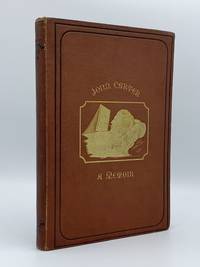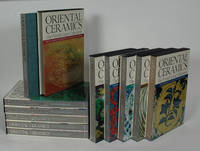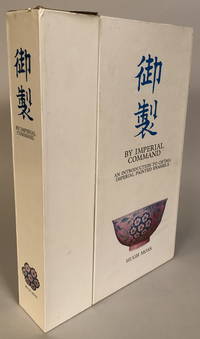
Payment Methods Accepted
About This Item
A fine collection of three original drawings by John Carter (31 July 1815 - 2 June 1850), an English mouth artist, together with a memoir and two autograph letters discussing Carter's work by William James Dampier, Carter's first biographer. The collection also includes a heliotype after a drawing by Carter as well as a list of subscribers to Dampier's memoir. The small collection was apparently presented by Dampier to one of his friends.
Original drawings by carter are rare, as most "of his work, now widely dispersed and probably unrecognized, is of course only known from nineteenth century reproductions" (Trevor Disley)
John Carter was born in Coggeshall, Essex, "of humble parents", as Dampier notes. At school "he showed a disposition to scribble the figure of a man, a horse, or a bird, upon his desk or copy book, when he should have been doing his lessons". On leaving school, he took up an apprenticeship as a silk-weaver, and subsequently set up on his own in 1835.
His private life was not without volatility, however. "Carter was accustomed to spend much of his earnings, and much of his time, at the public-house - a certain sign of a depraved condition, and of readiness for mischief." One Saturday in May, 1836, Carter and some friends were "attracted to the rookery at Holfield Grange, and John ... ascended first one of the tall trees in search of birds." He missed his hold and fell about 40 feet to the ground. The fall damaged three vertebrae, leaving him permanently paralyzed from below the neck.
Inspired by the example of Elizabeth Kinning, who had lost the use of her hands and learned to draw with her mouth, Carter began to draw with a pencil held between his teeth. He made quick and steady progress and began to copy the works of famous painters such as Rembrandt and Van Dyck. His skill drew the attention of the villagers, and eventually his fame extended far beyond Coggeshall, reaching even the United States.
Carter sometimes travelled in a small carriage drawn by a little boy. On 21 May 1850, the boy was "guiding the carriage down a slight descent." He tripped and lost his power, and consequently the carriage was thrown over, leaving Carter seriously bruised and shaken. Although at first Carter seemed to recover from the accident, he eventually contracted pulmonary affection and on "the Sunday evening (2nd June), about nine o'clock, [he] was taken to his rest."
In his own lifetime, Carter became a celebrity of sorts. He was the subject of newspaper articles and medical investigation, and among the collectors of his work was none other than Queen Victoria. Interestingly, after his death a part of his spine was donated to the College of Surgeons Museum, "where it will remain as a typical specimen almost unique in interest." The final plate in Dampier's memoir depicts the damaged portion of Carter's spine. The collection comprises:
John Carter. [Head of a Man, unfinished.] Pencil and pen and ink drawing. 11.7 x 9.4 cm. Annotation on verso: "Done by John Carter with his mouth. W Dampier Vicar". This drawing was reproduced as plate one in Dampier's memoir. The first reproduction was meant to be Carter's drawing of a butterfly. The printers note, on a leaf prior to the plates at the end of the memoir, that they were not able to successfully reproduce the butterfly drawing, and substituted this image of an unfinished head of a man.
John Carter. [Head of a woman, unfinished.] Pencil drawing. 12.5 x 18 cm. Annotations in pen and pencil in upper corners ("28a", "17a"and "pl. 14"), annotation in ink below the image: "Done by John Carter of Coggeshall with his mouth. W Dampier Vicar". This drawing was reproduced on plate 14 in Dampier's memoir.
John Carter. [Profile portrait of a man, study.] Pencil drawing. 18 x 14.5 cm. Upper corners with annotations in pencil ("30," 17"and "pl. 14"), annotation in ink below the image: "Done by John Carter of Coggeshall with his mouth. W Dampier Vicar". This drawing was reproduced on plate 14 in Dampier's memoir. With a sketch on the verso and some annotations, including "Lent by Hannah Carter" [the artist's sister] in Dampier's hand.
John Carter. Portrait of Charles I: heliotype reproducing a drawing by Carter after a painting by Van Dyck. 24,9 x 16,1 cm. Slightly foxed, a few small stains. Note in pencil by Dampier on verso: "For the kind acceptance of W. Hellger[?] W.D. Jan. 14 1876.
William James Dampier. A memoir of John Carter, by William James Dampier, MA., of Christ's Coll., Cam; Vicar of Coggeshall. A new edition. London, Coggeshall, Simpkin, Marshall & Co., Stationer's Hall Court; A.H. Coventry, Market End, 1875. Tall 8vo (25 x 17.5 cm). xxii, [3], 10-63, [3] pages. With photo-lithographed frontispiece and 27 photo-lithographed plates with tissue guards. Publisher's red cloth, the front board with central panel stamp showing a portrait of Carter. In very good condition with the corners bumped and the binding with some small areas of wear, some light foxing to the plates. Offsetting to plate one, where the original drawing was inserted previously. The memoir includes "A Catalogue of Works by John Carter and in Whose Possession."
William James Dampier. Autograph letter, signed, to a "Dear Sir", dated Ramsgate 14 Jan. 1876. 2 pages, 8vo. Dampier tells that he has sent some of Carter's drawings which he had received from the artist's sister, Hannah Carter, to Mr. Hepman(?), and suggests that the recipient see them and consider them for purchase. He offers them at "what I consider a fair and reasonable price for her to take." He writes that he is happy that the recipient liked the book, and that "there was no help for the poor butterfly" and sends the heliotype that is included in the present archive.
William James Dampier. Autograph letter, signed, to a "Dear Sir", dated Spencer House, Ramsgate, 19 Jan. 1876. 4 pages, 8vo. Dampier acknowledges the receipt of 2 guineas for the purchase of the drawings and responds to criticisms of the reproductions in the book: "photolithography will not at all reach some of Carter's works; but see p. xxi of the preface, and I should like to show you some day an American photograph I have of [Carter's drawing] ‘Innocence' - a beautiful thing. Mr. F[rederick] Mills of ... Boston ... might procure one if you wished it. He has the original and would I am sure be charmed to hear from anyone who takes such an interest in Carter's works as you do." Frederick Mills wrote another life of Carter, published in 1868.
Printed list of subscribers to the new edition of Dampier's Memoir of John Carter. One leaf. Text in double-column. Right edge slightly frayed and darkened.
Provenance: William George Mills (bookplate on pastedown in the book), possibly a relative of Frederick Mills; a printed leaf from a (1895?) bookseller's catalogue of G. Herbert of London lists this collection: "Mr. Dampier's presentation copy to a friend, with three of the original drawings and sketches of the illustrations inserted, and two autograph letters.".
Reviews
(Log in or Create an Account first!)
Details
- Bookseller
- Riverrun Books & Manuscripts
(US)
- Bookseller's Inventory #
- 406306
- Title
- Archive
- Author
- CARTER, John
- Book Condition
- Used
- Quantity Available
- 1
- Weight
- 0.00 lbs
- Keywords
- ABAA-NY
- Bookseller catalogs
- Art;
Terms of Sale
Riverrun Books & Manuscripts
All items are guaranteed as described and are returnable within 30 days. Please e-mail orders@riverrunbooks.com or call (914) 478-1339 to initiate your return. In your e-mail, please include your name, item(s), and reason for return.
Overseas orders should specify shipping preference.
All postage is extra.
New clients are requested to send remittance with your orders. Libraries may apply for deferred billing.
All New York residents must add appropriate sales tax.
We accept PayPal, American Express, Master Card and Visa.
All items are subject to prior sale; prices are subject to change.
About the Seller
Riverrun Books & Manuscripts
About Riverrun Books & Manuscripts
Glossary
Some terminology that may be used in this description includes:
- G
- Good describes the average used and worn book that has all pages or leaves present. Any defects must be noted. (as defined by AB...
- Poor
- A book with significant wear and faults. A poor condition book is still a reading copy with the full text still readable. Any...
- Foxed
- Foxing is the age related browning, or brown-yellowish spots, that can occur to book paper over time. When this aging process...
- Verso
- The page bound on the left side of a book, opposite to the recto page.
- Plate
- Full page illustration or photograph. Plates are printed separately from the text of the book, and bound in at production. I.e.,...
- Fair
- is a worn book that has complete text pages (including those with maps or plates) but may lack endpapers, half-title, etc....
- Spine
- The outer portion of a book which covers the actual binding. The spine usually faces outward when a book is placed on a shelf....
- New
- A new book is a book previously not circulated to a buyer. Although a new book is typically free of any faults or defects, "new"...
- Cloth
- "Cloth-bound" generally refers to a hardcover book with cloth covering the outside of the book covers. The cloth is stretched...
- Fine
- A book in fine condition exhibits no flaws. A fine condition book closely approaches As New condition, but may lack the...
- Shaken
- A hardcover in which the text block is loose, but still attached to the binding.
Also Recommended
-

Save 10% on every purchase!
Join the Bibliophiles’ Club and start saving 10% on every book.
$29.95 / Year















